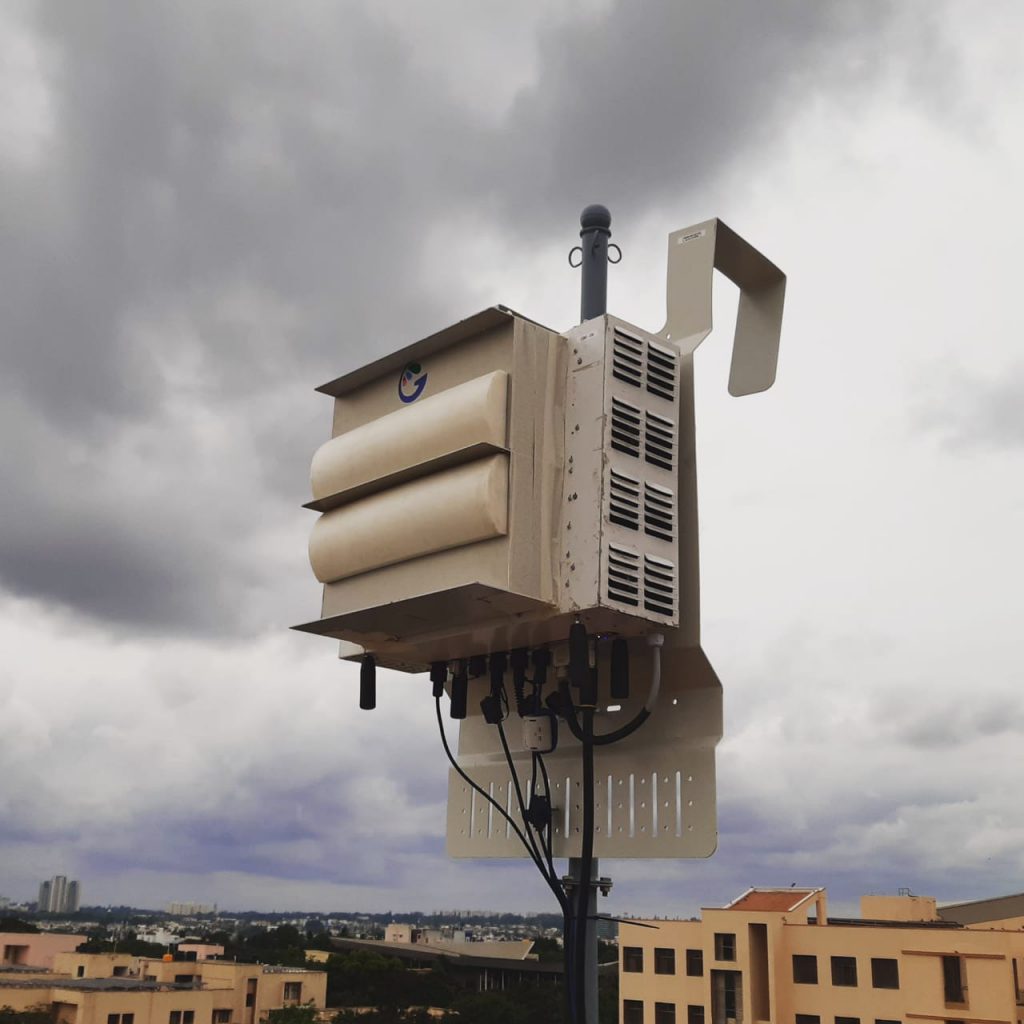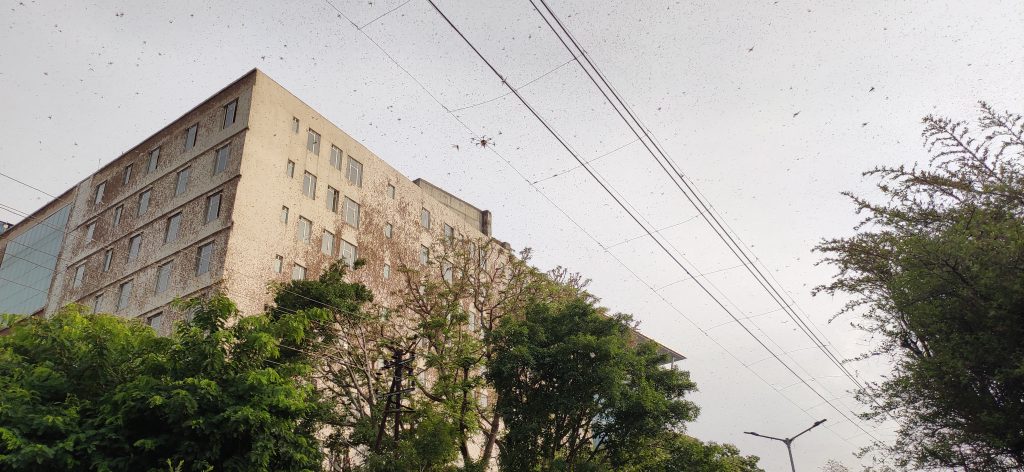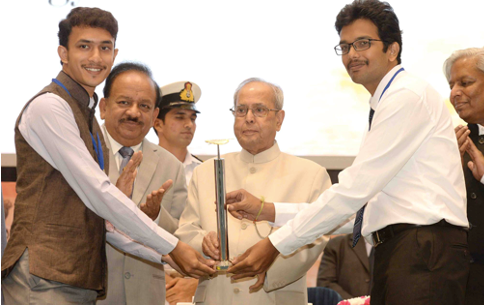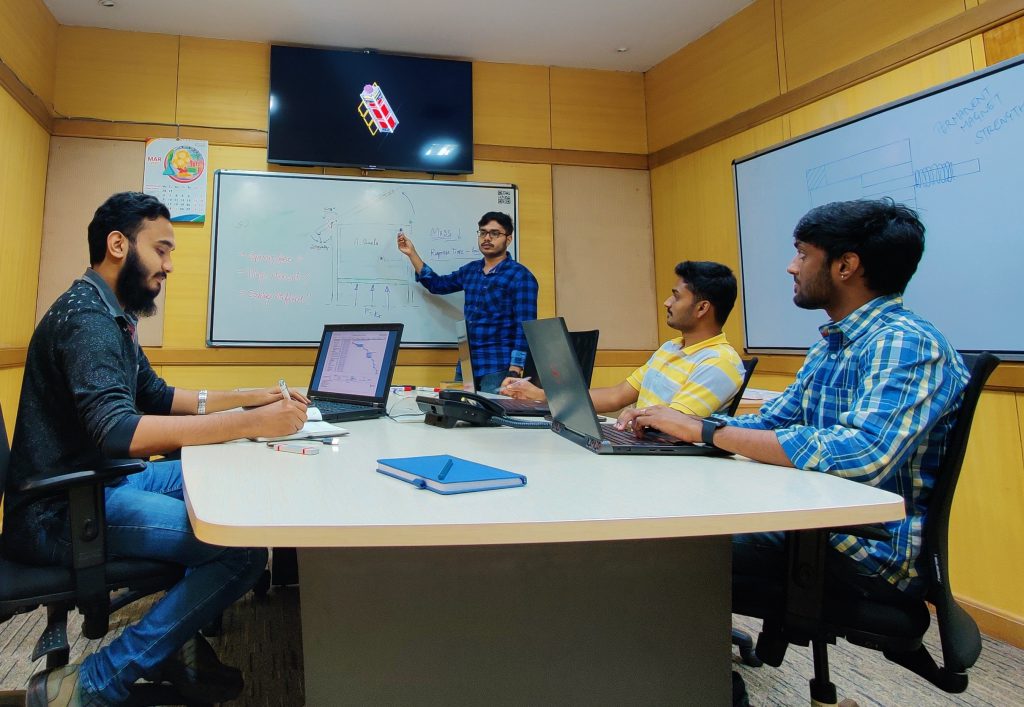With the commercial space sector recently opening to private players, these are exciting times for four aerospace start-ups incubated at IISc that are producing cutting-edge technology

Neha Satak and Prasad HL Bhat first crossed paths as Masters’ students in 2006 at the Department of Aerospace at IISc. While Satak went on to pursue a PhD in the US, Bhat continued as a PhD student at IISc. But similar motivations brought them together again in 2015. Both had grown up in small towns, and knew how connectivity could change lives. They were also passionate about space, and decided to combine these interests to build technology that connects people, no matter where they are. In 2015, they started a company called Astrome, with the goal of solving the Internet connectivity problem that exists in developing countries. They coined the company’s name from ‘Astronomy’ and ‘Me’, referring to their deep and personal connection to space.

Theirs is one of four start-ups incubated at IISc’s Society for Innovation and Development (SID) in the field of aerospace. And fortunately for them, in June 2020, the Indian government formed the Indian National Space Promotion and Authorisation Centre (IN-SPACe), and announced a Space Enterprise Encouragement and Development (SEED) programme by the Department of Space, heralding the beginning of a new era in India’s space technology sector. Aimed at supporting innovative solutions in space research and development that help India expand its market and reduce imports, these new schemes are expected to greatly enhance the role of space-related start-ups and MSMEs.
Internet from space
When Satak and Bhat started out, their first focus was on building a satellite constellation to deliver Internet services in rural areas, and to develop technology that enhances the value of satellite Internet. Their products use a new type of wireless technology that operates in the millimetre frequency range. The Ku frequency band in the microwave range (12 to 18 GHz) has been the most popular in the satellite communication domain, and is therefore pretty crowded. Astrome has developed products that use a much higher frequency band of 70 to 90 GHz, which is relatively uncrowded, has a high throughput and low cost of delivery.
Along the way, they realised that their technology could also be used to enhance the current telecommunications infrastructure. And their first product called “Gigamesh” was born. Gigamesh consists of a transceiver mounted on a tower that enables wireless communication between towers. The potential of this product has been recognised by the Government of India, and Astrome is one of the seven start-ups selected by the Department of Telecommunications as a candidate for the BharatNet project, a fibre deployment project to connect Gram Panchayats and villages. “So we are able to contribute to rural communication even before we go to space,” Satak says proudly. Astrome is also conducting demonstrations for the Indian Army and Navy, who expressed interest in Gigamesh due to its inbuilt security features and high bandwidth connectivity.

Satak divulges that very soon, Astrome will be an active player in 5G communications, not just in India, but all over the world. She reveals that they are also building a space communication product – a device that communicates with satellites to provide Internet to homes & businesses and also enable connectivity between remote telecom towers and satellites.
“We are able to contribute to rural communication even before we go to space”
A grant from the US-India Science and Technology Endowment Fund (USISTEF) was a game changer for Astrome, as it helped them to build the first prototype of their technology. Several other smaller development grants from the central and state governments such as Nidhi Prayas and Idea2PoC, and very recently, two iDEX (Innovations for Defence Excellence) grants, have enabled them to develop their technology further, as well as to commercialise their products.
Satak says that as a start-up, Astrome has gone through several avatars, and today, has become much more than a space technology company. She foresees 5G, rural and defence communications being a major part of their business in the next few years. But they have not lost their starry ideals, and plan to test their technology in space over the next two years.
Aerospace solutions for agriculture
Like Astrome, the goal of General Aeronautics (GA) is to find high tech solutions for social issues in the country. It was founded by Abhishek Burman, Anutosh Moitra, and Air Commodore PK Choudhary VSM (Retd), with the support of Professor Kota Harinarayana, Padma Shri awardee and alumnus of IISc. Burman had previously worked at the Aeronautical Development Agency (ADA) and the National Aerospace Laboratory (NAL). At NAL, he met Moitra, who had previously worked with NASA-Boeing and was with Tata Consultancy Services at that time. Choudhary was the Air Force representative at ADA, where Harinarayana was the first program director. The four of them felt that their combined expertise could be used to solve critical social problems, and decided to start something on their own.
In 2018, GA started looking at solutions to problems in agriculture, specifically at methods to improve yields and reduce crop loss due to pests and disease. Current methods for pest management involve spraying pesticides, which are not always efficient, and pose serious health hazards to the farmers. Between 2014 and 2018, there were more than 100 deaths in Maharashtra due to the inhalation of toxic pesticides while spraying. After discussions with government and private organisations working in the agricultural sector, GA realised that an aerial spraying technology using drones would be much more efficient than manual spraying. “Typically, the way they do [this is], they take a knapsack sprayer which holds 20 litres, and for one acre they need 200 litres, so they need to [repeat this] ten times. So it’s quite a cumbersome activity. And a drone today can do 100 acres in the same time,” says Burman. He adds that in addition to knowing how to spray, knowing when and where to spray is also important. Manual spraying is done in a blanket fashion on the entire field. But often there are only a few hotspots of infestation.
To address all these issues, GA has developed an AI-based system for early detection of disease and pest infestations, in collaboration with the Central Plantation Crops Research Institute at the Indian Council for Agricultural Research (ICAR). At present, this solution is developed for coconut plantations, where due to the height of the palms, it is difficult to check manually for early signs of infestations or disease. Their drones conduct periodic surveys of these plantations, and take images which are run through an algorithm that identifies hotspots. Coordinates of these areas are given to the customer, and the sprayer drone can then be deployed to those specific zones of infestation. The algorithm can also identify the disease or type of pest, so that an appropriate pesticide can be chosen. Soon, they plan to extend this precision agriculture system to other crops.

Burman says, “One of the biggest challenges in agritech is, how do you convince the farmer to use your technology? Many of these solutions have failed because the farmer is not willing to use [it]. It’s not very different even in our case… we realised that we need to speak in their language to connect with them.” To overcome this, they decided to partner with organisations who already have the backing of farmers. For large scale farmers, they do this primarily through the business-to-business route. The majority of farmers, however, have very small land holdings. To reach them, GA is working with Farmer-Producer Organisations (FPOs), local panchayats, and other agritech start-ups. They are also in touch with rural finance institutions that could provide loans to micro-entrepreneurs who could expand their reach.
“One of the biggest challenges in agritech is, how do you convince the farmer to use your technology? Many of these solutions have failed because the farmer is not willing to use [it]. It’s not very different even in our case… we realised that we need to speak in their language to connect with them”
The same system that was developed for the agricultural sector was repurposed during the lockdown for hotspot disinfection in Karnataka and Orissa. The Bangalore and Orissa police also used these drones for surveillance to maintain social distancing, and to broadcast COVID-19 related announcements in containment zones.

This system was also used in Rajasthan and Uttar Pradesh to spray insecticides to curb the severe locust infestations that swarmed through large parts of the country early this year.
Currently, they are also testing the use of drones in reducing road accident fatalities. Reaching the accident site before the ambulance, these drones would carry a box containing an “active blood control kit”, and be fitted with an audio-visual facility through which a doctor can guide bystanders to provide first aid to accident victims.
Since all four founders of GA came from a highly technical background, they had a lot to learn at the business end. They needed a fresh perspective, which was provided by Ramaseshan Satagopan, who joined them in 2018. Satagopan had previously worked with the Defense Research and Development Organisation (DRDO), but also had many years of experience working with large engineering services companies. Burman adds that Satagopan brought in a lot of business thinking, and played a major role in shaping GA to what it is today.
New propulsion systems
While Astrome and GA focus on earth-bound problems; Bellatrix, also nurtured at SID, sets its sights on satellites, inventing novel and cleaner technologies to manoeuvre them in space.
As an Aeronautics student in Coimbatore, Rohan Ganapathy, one of Bellatrix’s founders, was working on a new type of propulsion system for satellites, called microwave plasma thrusters. His project received CSR funding from JSW Steels, and he was joined by family friend and electrical engineer Yashas Karanam. Soon after, two of Ganapathy’s juniors, Vivek Murugesan and Saagar Malaichamy, came on board. Their experience working on this project motivated them to form a company, and in 2015, Bellatrix was born.
“We thought we should have a long vision and our name should reflect the vision. And we were thinking probably 100-200 years from now, if people start developing advanced propulsion that can go very fast and go to very vast distances…as a propulsion company we need to be pioneers in developing such technology, even 100-200 years down the line”
One of the major milestones in their journey to becoming a start-up was meeting the Chairman of ISRO at a college event. They showed him some photographs of the technology they had developed, and ended up getting a contract from ISRO to develop it further. Bellatrix, being a deep tech start-up, felt a growing need for regular access to lab facilities, and decided to apply to SID for incubation. Their proposal was selected, and their incubation at IISc started in Oct 2016, after which they moved to Bangalore. By this time, they were a big team in need of a dedicated lab. SID supported this by providing a lab space of 2000 square feet, where Bellatrix could develop and test their propulsion technologies.
Bellatrix has a diverse portfolio, and makes competitively priced products for all the weight classes of satellites. Currently, they are working on four different products – nano thrusters or dedicated propulsion for nano satellites (with support from the Centre for Nano Science and Engineering or CeNSE), chemical propulsions systems (with the Department of Aerospace), unique green propulsion systems, and a new kind of electrical propulsion system. They are also working on a new and more efficient rocket engine. They have won several awards, most notably the TDB National Award (Technology Development Board) in 2017, and have recently raised funds of up to $3 million, which has enabled them to develop a sustainable business model, develop their technology further, and expand into global markets.

Bellatrix is named after the third brightest star in the constellation of Orion. “When we were deciding on a name,” reveals Karanam, “we thought we should have a long vision and our name should reflect the vision. And we were thinking probably 100-200 years from now, if people start developing advanced propulsion that can go very fast and go to very vast distances… as a propulsion company we need to be pioneers in developing such technology, even 100-200 years down the line.”
Tackling the space jam
As Bellatrix’ stint at SID was taking shape, they were contacted by a younger start-up called “Digantara” (Sanskrit for “space”), which had recently received a grant from the MSME Centre of Excellence at IISc. Digantara was curious about their experience at SID. Bellatrix’ positive feedback and guidance encouraged them to approach SID. They were chosen for incubation, and moved into their own office space in August 2020.
Anirudh Sharma and Rahul Rawat were pursuing a degree in computer engineering at Lovely Professional University in Punjab, when they started building satellites as part of the ISRO student satellite launch programme. During this time, they became aware of the challenges faced by the industry due to increasing junk in space. A little more research revealed that various satellites have been lost due to hits by space debris. All this made them realise that there are huge gaps in the management of space traffic, and that only 1% of objects in space are currently being tracked, worldwide. At the same time, thousands of new satellite constellations are being launched by companies like SpaceX, Amazon, Planet, etc., making safe navigation for spacecraft the need of the hour. To address this, the duo formed a company in 2018 with the goal of developing technological solutions to track space junk through an in-orbit space debris monitor. Soon after, they were joined by another partner, Tanveer Ahmed, who was a student of aerospace engineering from RV College, Bengaluru, and the trio started developing their technology together.

(Photo courtesy: Rahul Rawat)
Digantara’s members have come a long way since their student days, in a relatively short period of time. Talking about the award they won at the National Systems Engineering Conference (INAC 03) in 2017, Sharma says that “winning [this] even though there were a lot of people from aerospace or MTech backgrounds, gave us a lot of confidence and the belief that more than what you study, if you have the passion, you can achieve pretty much everything.” Riding high, they applied to international events, and were selected as one of the top eight start-ups in the world (and the only one from India) to participate in the International Astronautical Congress (IAC) in Washington DC in 2019. Digantara recently attended Satellite 2020, one of the largest space industry conferences, where Elon Musk was the keynote speaker, and signed several partnerships with international companies. They managed to come back to India just a day before the lockdown. Right now, Digantara is India’s first air and space surveillance company, building two types of technologies – one that tracks aircraft and one that tracks space debris. Their nanosatellite constellations will distribute satellites at different orbits for these two different targets.
Digantara recently attended Satellite 2020, one of the largest space industry conferences, where Elon Musk was the keynote speaker.
Younger start-ups like Digantara also have a major advantage, with lots of opportunities as the Indian space industry opens up to private players under the newly announced schemes introduced by the Government of India.

(Photo courtesy: Rahul Rawat)
From scientist to entrepreneur
As engineers, Sharma and Rawat from Digantara did not know much about running a business. So they signed up for a three-month-long acceleration program at the Indian Institute of Management (IIM) at Udaipur. They also attended the Nexus Start-up Hub 2020, a training programme in entrepreneurship skills, conducted by the US Embassy, Delhi in collaboration with the Alliance for Commercialization and Innovations Research (ACIR).
While Digantara developed their business acumen by attending training programmes, Karanam at Bellatrix believes that circumstance is a great teacher, and that an MBA isn’t necessarily enough to run a company. Similarly, Satak from Astrome believes that entrepreneurial skills are learnt on the job. Her advice for newcomers to the start-up ecosystem is to “Be open to change…keep your eyes on the market, and whatever the market demands, you have to pivot, and you have to pivot quickly.”
“Be open to change…keep your eyes on the market, and whatever the market demands, you have to pivot, and you have to pivot quickly”
Burman from GA advises newcomers, especially in the hardware segment, to “Ensure that there is a market and scale for the product you are developing, and have a balanced founding team with complementing skills”. He adds that bootstrapping is the best way to start, as having the comfort of large funds can lead to a loss of focus. On raising funds, he recommends that startups treat investors as co-founders. “Try to be as transparent as possible. You should have enough logic and argument in what you are saying to convince the investor. Otherwise he can put his money in an FD [Fixed Deposit], why should he come to you?” he quips.
To read more articles in this series about start-ups incubated at IISc, click on the links below:
Building Intelligent Technology
How MedTech Start-ups Incubated at IISc Aim to Simplify Lives




